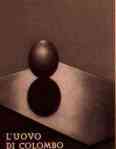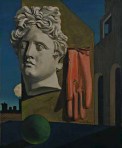Screen Memories
This image is from the promotional brochure for the launch of Giovanni Boggeri’s avantgarde Studio Boggeri in Milan in 1933. I have captioned it Erect Egg to hint at my adopting it as a mnemic image or screen memory.
A screen memory is an enigmatic memory whose fascination seems out of proportion with its ostensible content. Its psychic power contrasts with the trivial seeming content. The term was introduced by Sigmund Freud in an early paper (1899). He described a screen memory as one that stands in for either a prior or a subsequent disturbing memory. It disguises the original shocking memory, while the persisting vividness of the screen memory (and thus does Freud argue) indicates the importance of keeping the experience alive in the psyche. He wanted to be able to explain ‘the occurrence of these mnemic images, whose innocence makes them so mysterious’ (Freud, 1899 in Standard Edition 3, p.307).
Certain photographers and painters are able to present a relatively everyday arrangement which vibrates with darker undertones and which can reach disturbing levels in the viewer more directly than an obviously shocking picture. Bill Brandt is one such. He can present an ordinary scene in an unsettling light which is far removed from the melodramatic devices of the film noire. Bill Brandt’s 1937 photograph of Halifax or the well known shot of Francis Bacon on Primrose Hill are good examples of this, but above all, for me, Top Withens, 1945.
In his metaphysical paintings Giorgio De Chirico used unexpected juxtapositions of elements from classical architecture and the paraphernalia of the designer’s studio (hardly everyday!) to create a tenor of loneliness and anxiety like his Song of Love (1914) or The Melancholy of Departure (1916).
‘The term metaphysical represented to de Chirico a search for the essential meaning behind the surface of objects. He beieved that objects acquire various meanings when imbued with the memory of their viewer. If that which de Chirico called ‘the chain of memories’ is broken the objects acquire a new and disquieting guise, “a ghostly and metaphysical aspect that only a few individuals can see in moments of clairvoyance and metaphical abstraction”‘ (Jose Maria Faerna, 1995 De Chirico, New York: Abrams). With names like The Enigma of the Arrival and the Afternoon, The Mystery and Melancholy of a Street the paintings seem to me to be workings and reworkings of a screen memory. Thus they seem to be about both being left behind and an unknown destination. It reminds me of Freud’s statement ‘that two psychical forces are concerned in bringing about memories of this sort. One of these forces takes the importance of the experience as a motive for seeking to remember it, while the other – a resistance – tries to prevent any such preference from being shown. These two opposing forces do not cancel each other out. Instead a compromise is brought about… What is recorded as a mnemic image is not the relevant experience itself – in this respect the resistance gets its way; what is recorded is another psychic element closely associated with the objectionable one – and in this respect the first principle shows its strength, the principle which endeavours to fix important impressions by establishing reproducible mnemic images’ (op.cit. p.307).
An example of such an image Freud mentions in this paper, someone’s earliest memory dating back to the ages of 3 or 4: ‘a table laid for a meal and on it a basin of ice’ (p.306). The psychoanalyst aims to demythologise the screen memory; the artist to exalt it; he deals in tags and their untoward force. A comment about the works of De Chirico I discovered in a blog: ‘des oeuvres, parce que j’adorais deja sans le savoir’ expresses the latter view – I adored them without understanding. But it is the aggravation these images cause that brings them close to being screen memories.
I took this picture on an oil rig in the Fortes Field. I don’t know what it means; I think for me it is a screen memory and stands in for something I haven’t much hope of bringing to mind. Whether of not it speaks to anyone else in this way (as an engaging enigma) may determine its value as art.
-
Recent
-
Links
-
Archives
- June 2008 (1)
- January 2007 (1)
- November 2006 (2)
- October 2006 (1)
- September 2006 (4)
- August 2006 (4)
- July 2006 (2)
-
Categories
-
RSS
Entries RSS
Comments RSS







